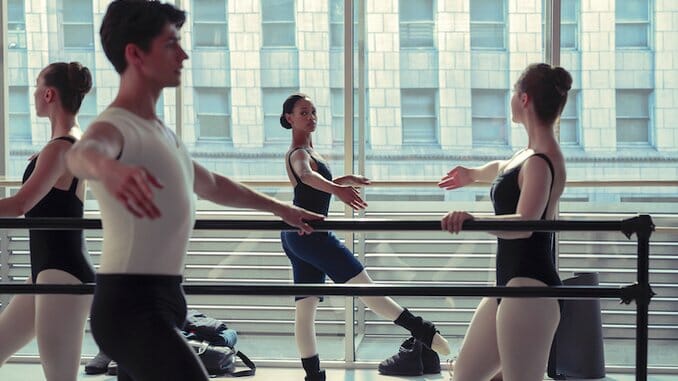Tiny Pretty Things Is No Center Stage, but It Has Its Own Messy Charm
Photo Courtesy of Netflix TV Reviews Tiny Pretty Things
Netflix’s Tiny Pretty Things is exactly what someone might expect from a bad teen murder soap opera. The dialogue is often tired, the archetypes are predictable, the villains are cartoonishly villain-y, and the cliches are too numerous to count. At first, each character is more archetype than human. There’s a misunderstood Muslim boy who gets a hard time from his roommate for praying, a spoiled rich blonde girl who gets everything she wants, a gay boy who hooks up but can’t commit, and an Asian girl who pushes herself because of her Tiger mom. There’s every trope you could imagine at a high school for dancers: bulimia, backstabbing, addiction to pain killers, a teacher sleeping with a student, and a jerk choreographer. And yet by the end of the 10-episode first season of Tiny Pretty Things, I wanted to see what happened next.
I consider Center Stage to be the best dance movie and Pretty Little Liars to be an off-the-rails treat, and if you agree, you will probably also like Tiny Pretty Things—though Tiny Pretty Things is not as good as either. It doesn’t push the teen murder show genre forward, but it does solidly do its job of creating an enticing whodunnit filled with teenage drama. Where Pretty Little Liars could drag out its mysteries to unsatisfying endings, Tiny Pretty Things doles out new clues in a timely and satisfying way, with an ending that complicates the story and sets the show up for a new season and a new mystery.
The show opens with a Black ballerina from California named Neveah (Kylie Jefferson) getting a call from a ballet school in Chicago. Though they had denied her at her audition, the school wants her now to fill a spot created when the best dancer at the school fell four stories off a roof. That dancer is now in a coma, and the school wants to shift how it’s percieved. Instead of a place where someone jumps off the roof, they want to be seen as a school that gives poor Black girls a chance to be prima ballerinas. (At one point during Tiny Pretty Things, a newspaper writes about a sex scandal with underage girls at the school and the headline is “Tutu Close for Comfort.” It is not subtle or particularly sensitive.) As Neveah navigates her new surroundings, she finds that she can’t trust anyone and danger lurks everywhere.
The flat, stereotypical characters give way to actual teens somewhere halfway through the season. And while the villains remain cartoonishly evil, the show begins to dig into what it means to be without power in a world where adults are complicit in harming children if it means creating something that looks beautiful—as long as you don’t look too close.
Once the show realizes that systems are scarier than jealous teens, it starts to click into place. Over the course of its first season, Tiny Pretty Things comes to understand that a greater and more complex evil than a shadowy figure who pushed a ballerina off a roof is a world that abuses those who are vulnerable. Complicity becomes the real enemy and one that is much harder to defeat: Even if one bad guy is taken down, a system exists to prop another up in their place. When every student is trapped in an environment that could lead to harm at any turn from those who are meant to protect them, the story becomes deeper and more compelling. These themes are also illustrated in Neveah’s backstory, which includes police shooting an innocent young Black kid and incarcerated family members. (Not subtle!)
One thing Tiny Pretty Things offers that other teen murder shows don’t is dancing. The actors are really dancers, and dancing is a big feature of the show. While it may be just another teen soap in some ways, for those who are interested in dancing along with some light murder, there’s a lot to see and enjoy.
Just as the story meshes better over the season, the acting improves as well. The show is most interesting when the students band together instead of being antagonists, creating layered relationships instead of one-note enmity. The dialogue, though, never rises as high as the dancers leap across the stage. The sex is extremely explicit for a show about teenagers, so much so that I wouldn’t be comfortable watching with an actual teen, and all the brunette boyfriends tend to blur together. Yet, even with all its over-the-topness and cliches, by the end of the season, there were characters I was rooting for and people I was shipping. It’s not great television, but it is a fun ride and you know what you’re getting—and sometimes that’s enough.
Tiny Pretty Things premieres Monday, December 14th on Netflix.
Rae Nudson is Chicago-based writer and critic whose writing has appeared in Esquire, The Cut, and Hazlitt, among other publications. Her book is All Made Up: The Power and Pitfalls of Beauty Culture, from Cleopatra to Kim Kardashian will come out in 2021. You can follow her on Twitter @rclnudson.
For all the latest TV news, reviews, lists and features, follow @Paste_TV.